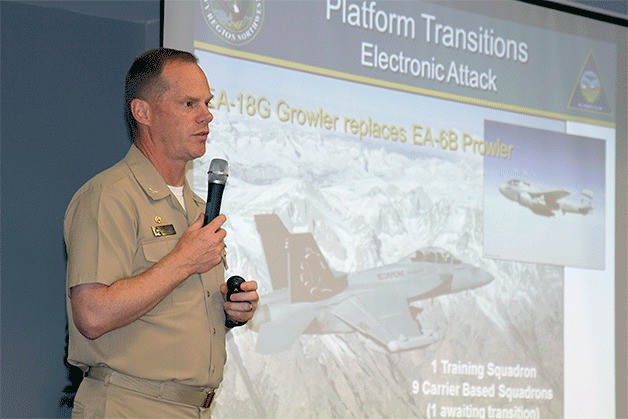At a gathering of area business leaders Thursday, the commanding officer of Whidbey Island Naval Air Station described a base that’s on the rebound.
NAS Whidbey, which peaked at approximately 9,000 active duty personnel in about 1994 and dropped to fewer than 7,000 personnel in 2013, will rise to about 9,000 by the year 2018, according to Capt. Mike Nortier.
The active duty population is projected to settle back to just over 8,000 by 2020.
Current construction at the base, and work planned in the near future, “is setting the foundation for the next 30 to 40 years of naval operations,” Nortier told an audience attending his State of the Station address at the Oak Harbor Chamber of Commerce monthly members’ forum.
In addition to protecting the United States, he said, NAS Whidbey is crucial in preserving commerce in the Pacific region and the ability to conduct transit in the Pacific.
And that’s why the anti-submarine P-3 Orions — which will eventually be replaced by the P-8A Poseidon — will see squadron numbers increase on Whidbey from three to six over the next several years.
“Where else are we going to put them in a better position?” Nortier asked.
Nortier also talked about NAS Whidbey’s near perfect location for training fliers in “unencumbered” air space. With about 39,000 square miles of area to practice in, the region offers diverse terrain. That includes areas over water and the Olympic and Cascade mountain ranges.
To prevent ever having to share that space with commercial and other aircraft, Nortier said, “We set aside those air spaces with the FAA 40 years ago.”
“Whidbey Island is an invaluable gem for the Navy and the national defense.”
The base’s presence also benefits the public in ways not often noticed, he said.
NAS Whidbey provides radar services in the region for civilian traffic, for example, for aircraft arriving and departing Friday Harbor in the San Juan Islands.
About half of NAS Whidbey’s operations have nothing to do with the military, he said.
Outlying Field Coupeville is a strategically important site for the Navy, Nortier said.
The runway very closely represents an aircraft carrier, and there’s very little “light pollution” in the area, he said. “It offers one of the best training assets we have here.”
OLF Coupeville is the target for a Central Whidbey group suing to stop touch-and-go landing practices by the EA-18G Growler, which is replacing the EA-6B Prowler.
In April, the Citizens of Ebey’s Reserve, or COER, filed a motion in Federal Court asking a judge to rule that the aircraft be forced to stop using OLF Coupeville until the Navy completes an Environmental Impact Statement.
The EIS isn’t slated to be completed until 2017.
COER members claim the Growler is louder than the EA-6B and has caused some of its members to suffer hearing loss and health problems and to deflate property values.
“Definitely when the aircraft are flying over, you’re going to hear them,” Nortier told the chamber audience., adding the Navy strives to minimize the impact on citizens.
When OLF Coupeville is closed to landing practices, the result is aircraft “stack up” at Ault Field on North Whidbey, the Navy’s primary runway on the island. It also forces the aircraft to practice in other areas that aren’t typically under the flight path.
During 2014, NAS Whidbey’s Search and Rescue conducted 18 rescues, 10 medivacs and seven searches, and eight medicvacs, two rescues and one search so far this year. SAR was among the first responders on scene after the devastating landslide in Oso in March 2014.
Among the more than $21 million in capital improvement projects either underway or planned for the base are a future P-8A simulator that will be operational by July 2016 and an $8 million fuel pier breakwater, Nortier said.
Last year, $105 million was spent adapting hangars on base to accommodate the larger tail of the P-8As.
Approximately 70 percent of the work on projects at the base go to local subcontractors such as Kreig Construction, according to the base’s figures.
Infrastructure at NAS Whidbey is valued at more than $1.7 billion.




